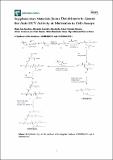Por favor, use este identificador para citar o enlazar a este item:
http://hdl.handle.net/10261/233796COMPARTIR / EXPORTAR:
 SHARE SHARE
 CORE
BASE CORE
BASE
|
|
| Visualizar otros formatos: MARC | Dublin Core | RDF | ORE | MODS | METS | DIDL | DATACITE | |

| Título: | Janus dendrimers to assess the anti-HCV activity of molecules in cell-assays |
Autor: | San Anselmo, María CSIC ORCID; Lancelot, Alexandre; Egido, Julia E.; Claveria-Gimeno, Rafael; Casanova, Álvaro; Serrano, José Luis CSIC ORCID; Hernández-Aínsa, Silvia; Abian, Olga CSIC ORCID; Sierra, Teresa CSIC ORCID | Palabras clave: | Dendrimers Micellar aggregates Self-assembly Drug delivery Hepatitis C Antiviral drugs |
Fecha de publicación: | 7-nov-2020 | Editor: | Molecular Diversity Preservation International | Citación: | Pharmaceutics 12(11):1062 (2020) | Resumen: | The use of nanocarriers has been revealed as a valid strategy to facilitate drug bioavailability, and this allows for expanding the drug libraries for the treatment of certain diseases such as viral diseases. In the case of Hepatitis C, the compounds iopanoic acid and 3,3′,5-triiodothyroacetic acid (or tiratricol) were identified in a primary screening as bioactive allosteric inhibitors of viral NS3 protease, but they did not exhibit accurate activity inhibiting viral replication in cell-based assays. In this work, dendritic nanocarriers are proposed due to their unique properties as drug delivery systems to rescue the bioactivity of these two drugs. Specifically, four different amphiphilic Janus dendrimers synthesized by combining 2,2′-bis(hydroxymethyl)propionic acid (bis-MPA) and 2,2′-bis(glyciloxy)propionic acid (bis-GMPA) functionalized with either hydrophilic or lipophilic moieties at their periphery were used to entrap iopanoic acid and tiratricol. Interestingly, differences were found in the loading efficiencies depending on the dendrimer design, which also led to morphological changes of the resulting dendrimer aggregates. The most remarkable results consist of the increased water solubility of the bioactive compounds within the dendrimers and the improved antiviral activity of some of the dendrimer/drug aggregates, considerably improving antiviral activity in comparison to the free drugs. Moreover, imaging studies have been developed in order to elucidate the mechanism of cellular internalization. | Descripción: | 24 pags., 8 figs., 3 tabs. -- This article belongs to the Special Issue Dendrimers and Dendritic Materials against Infectious Diseases | Versión del editor: | https://doi.org/10.3390/pharmaceutics12111062 | URI: | http://hdl.handle.net/10261/233796 | DOI: | 10.3390/pharmaceutics12111062 | E-ISSN: | 1999-4923 |
| Aparece en las colecciones: | (IQF) Artículos |
Ficheros en este ítem:
| Fichero | Descripción | Tamaño | Formato | |
|---|---|---|---|---|
| Janus Dendrimers.pdf | Artículo principal | 4,46 MB | Adobe PDF |  Visualizar/Abrir |
| Supplementary Materials.pdf | 1,39 MB | Adobe PDF |  Visualizar/Abrir |
CORE Recommender
PubMed Central
Citations
3
checked on 05-abr-2024
SCOPUSTM
Citations
7
checked on 01-may-2024
WEB OF SCIENCETM
Citations
6
checked on 22-feb-2024
Page view(s)
65
checked on 03-may-2024
Download(s)
125
checked on 03-may-2024

